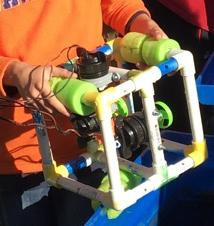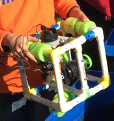

分水岭创新实验室
我们的 Mission is to make the Chester River the best understood river in the world and to use this data in schools to teach students about the environment.
The 分水岭创新实验室 (WIL) creates unique devices to help understand, observe, teach and involve our students in research that shows us how watersheds work.
From building water quality monitoring buoys to creating remote controlled boats to map water quality data, the 分水岭创新实验室 is a space for exploring the depths through creative technologies.
The 分水岭创新实验室 also recruits students to help us deliver STEM programs 到K-12班. These programs include anything from aerial imaging with kites to tagging trees for observation to building underwater robots.
Dr. 道格·莱文, who directs the WIL, is supported by an Ennovation Grant from the Maryland State Department of Commerce to create a Maryland based business focused on buoys (Basic Observation Buoys(BOBs)) that collect water quality data. 水质系统 provided through a partnership with In-Situ Inc (Fort Collins, Colorado).
我们做什么

水质监测
In the 分水岭创新实验室, we focus our efforts on monitoring water quality 在切斯特河. 我们的 goal is to establish a correlation with water quality along the entire Chester River with agricultural practices and the occurance of rainfall.
- 水质监测浮标: We build buoys that collect and transmit water quality data, along with data for
水产养殖与工程. These buoys are launched throughout the Chester River
for us to monitor, along with other bodies of water that are monitored by other organizations.
- Remote Control Boats (ROVERS): In a project with NASA, we also build remote control boats (ROVERS) that collect
water quality data that can be mapped. WAC的学生 helping with the design of
these boats, creating the methodology of operating them, and learning the most informative
ways to present the data gathered from them.
Sailbotz: We are also building Sailbotz, or unmanned sail boats, that collect and transmit GPS和水质数据.
These are launched in global ocean currents to map the water temperatures, chlorophyll a, and other parameters to match with NASA satellite measurements. WAC的学生 helping with the design of these boats and the use of the data gathered from them.

遥感
27英尺的科考船 月鲹 is used with different remote sensing devices to make high resolution. 我们使用side scan sonar to map underwater habitat, multibeam to map the depths across the bottom, sub-bottom profilers to look at the geology beneath the river bottom, and a magnetometer to find evidence of 海难s or other, iron laden, man-made objects. 学生们 shown how to use the different systems that are available for independent research 以及高级论文.
研究舰队
干教育
We create programs for STEM education. These programs range from creation of an underwater robot, to building your own buoy, to aerial imaging with kites. 请参阅下文 descriptions of our STEM programs.
STEM教育项目
Design, build, and operate a working underwater robot in a little more than an hour. 这 program has been used down to third grad and used right through professional development for educators and more. Using PVS parts, pool noodles, and a controler wired with bilge pump motors, an underwater robot frame is built and connected to 一个30英尺(10米)长的绳索. Powered by a 12v battery held in a backpack, the Aquabotz can be "swum" in a pool with a camera or used to pull a self-made (student constructed) plankton tow, The camera is used for observation and the plakton tow to examine after the deployment to see what is lurking in the water column.
Aquabotz can be purchased as a "ready to go" kit with, or without, an underwater camera. There are enough pieces to allow multiple frame designs. 控制器有保证 一年. Aquabotz with prebuilt controller, fram pieces and waterproof camera - $400 (battery not included), plus shipping. Get in touch for more details and to 讨论项目需求. NGSS lesson plans are included.
联系 (电子邮件保护) 了解更多信息.
 |
 |
 |
| 这 is a 样本Aquabotz getting ready to be put in the water. | The operator has the 电池的背包 on and is controlling the Aquabotz in the water 在她面前. | 这 Aquabotz is sporting a nylon plankton tow being pulled behind it. 经过几 minutes the robot is recovered and trapped contents are washed into a jar for further 显微分析. The analysis includes plankton and plastic bits. |
We challenge all age groups to build a buoy that will break the “world's record” for the number of golf balls it can hold or how high it can stand without tipping over. 我们的 students present this challenge to K-12 groups all over our 2 counties. 小浮标 are built with PVC pieces that hold over 50 golf balls, or stand a meter high without 摔倒. An indoor/outdoor thermometer is attached to create an observation buoy that measures water and air temperature. BABs program kits that service 30 students at a time will be available as a user resource. A website holds photos of records and prints certificates of achievement. Students leave knowing that buoys “mark underwater roads” and collect/transmit data.
In a NASA partnered project, kites are flown with a device that takes pictures of the ground and senses the degree of moisture it contains. 学生们学习如何飞行 kites that complete a mission to map the ground being flown over.
-
农业的 – Concepts of agriculture and farming and ecology are explored to support sustainability. Demonstration gardens are designed, installed and monitored on school grounds.
-
鲍勃和弗洛斯 – Authentic data is measured and plotted using water quality monitoring systems 气象站. Visually explicit data changes (Data Fountain) are monitored through the day and shown on large monitors installed in common school areas. Causal relationships are visualized between water chemistry, weather, and land use.
-
问题调查 – the skill of identifying social issues that pervade in environmental investigations and using real data to support different viewpoints will be demonstrated. 参与, Explore, Explain, Elaborate, and Evaluate – In our programs, a 6th “e” is added as “Empowerment” – which is defined as an “action item” where intrinsic worth adds intangible value to the lesson.
-
它的电 – Educators work with solar panels and miniature turbines to convert sun and wind 电. They also explore battery science with fruits and vegetables. 所有 that is learned will be transferrable to K-12 classrooms. 这包含了一个“绿色” challenge” where students work to reduce their school’s per capita energy use in competition with others in their Schoolshed. (Add model railroading to explore circuitry & (运输)
-
这是给鸟儿们的 – Educators are taught bird identification and basic avian science. 建立链接 to climate and weather, biology, geography (bird migrations), and pollination. 30 sets of binoculars and bird ID books are available for delivery to schools. 鸟屋, Bee hives, Bat Houses, Butterfly houses and gardens are installed on school properties.
-
K-12课程整合 – 杰迈玛克拉克 works with counties to align all One Watershed programs with Federal, State, and 本地学习标准.
-
Sailbotz – Using a free floating, unanchored “buoy” with a sail, we explore ocean currents and how to use this as a vehicle to connect students to foreign cultures, unfamiliar climates, and varying habitats.
-
飞越领空 – Educators are taken up in an airplane and shown their watershed from the air.
-
感觉它 - electronic components and a multi-meter show educators how to build sensors that use voltage to measure change and use graphs and math to convert the voltage to physical measurements – temperature, conductivity, and more. (adapted from Liesl Hotaling, 感觉它)
-
地方感 – Research Boats, kayaks, canoes, and hiking are used to transit water bodies across the park limits, using observation and sampling devices to characterize the different habitats and bring “intimacy” between the park and its’ educators. 这个PDM可以扩展 超过两天.
-
沉船 -在下列地区 水下文化 artifacts are identified, they will be imaged with seafloor mapping equipment and their history and provenance identified. 这 interdisciplinary opportunity touches governance, economics, industry, social history, ag-history, and technology. 水下 imagery has been plotted on 30’ x 25’ on billboard vinyl – students walk on it and 像在水下一样解读.
-
StoryMap – Educators learn how to use handheld GPS units, computer based maps and online tools to create virtual and real fieldtrips incorporating learning objectives and storytelling 与当地地标相连.
-
TREEs (Tree Research for Environmental Education) – Trees in schoolyards are tagged with QR-codes. Each tag is linked to the mapped, GPS coordinates of the tree, its species, height, and girth (at 1m). 照片被存档 in the web-searchable data base each year. The trees are adopted/assigned to students and monitored throughout their academic career (12 yrs). 在未来,树木会 be DNA fingerprinted and that information archived in a searchable database. 这 program was developed to meet NGSS research needs of all ages.
-
向上,向上,然后离开 飞行科学 – Kites, Balloons, Paper Airplanes, Unmanned Aerial Systems (Drones) are brought systemically 进入K-12教室. Educators learn flight science and remote sensing and how to present it to their students at all ages. Select educators will qualify for their certificate to legally pilot Unmanned Aerial System (UAS).
-
虚拟实地考察- X,Y,Z – Use remote control boats and trucks to collect GPS referenced data – spectral imagery, 热测绘,测深. (规划)
